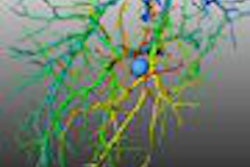
NEW YORK (Reuters Health), Oct 2 - A management algorithm, based on a review of published reports, may assist clinicians in deciding on appropriate therapy for men with prostate cancer recurring after external-beam radiotherapy (EBRT), according to a paper in the September issue of BJU International.
"The algorithm we present," lead investigator Dr. Tim Dudderidge told Reuters Health, "is a starting point for clinicians managing patients with biochemical failure. We hope it stimulates debate and increases interest in technology in urology."
Dr. Dudderidge of University College London Hospitals NHS Foundation Trust and colleagues note that in 1997 the American Society for Therapeutic Radiology and Oncology (ASTRO) produced criteria to define biochemical failure after RT. These were revised at an ASTRO conference in Phoenix in 2006.
The European Association of Urology and the Royal College of Radiologists' Clinical Oncology Information Network have also developed guidelines for following patients with prostate cancer and there have been a number of studies in the area.
However, the researchers note that many patients with biochemical failure might not need or will not be suitable for salvage treatment. Among these are patients with metastatic disease and those in poor health. Patients might also refuse treatment due to the risks of associated with therapy.
After EBRT, the researchers note that follow-up should be three-monthly until the prostate-specific antigen level has reached a stable nadir after withdrawing androgen suppression. The Phoenix definition of biochemical failure, they add, is an increase of 2 ng/mL or more beyond that level.
Laparoscopic lymph-node dissection can useful in excluding micrometastases in high-risk patients and contrast-enhanced MRI can be used for both diagnosis and staging in conjunction with prostate biopsies. However, to avoid false positive results, it should be employed no sooner than three years after EBRT.
Patients should be offered as many options as possible, the authors advise. Deferred androgen suppression, laparoscopic or open radical prostatectomy, cryotherapy, and high-intensity focused ultrasound are among reasonable salvage treatment approaches, they observe.
However, they conclude, "minimally invasive salvage therapies seem to offer an advantage over salvage surgery to patients in whom the benefits and harms are so finely balanced."
In fact, Dr. Dudderidge added, "with salvage prostatectomy seeming unattractive for many patients, the emergence of minimally invasive techniques for radiorecurrent prostate cancer offers new hope for many."
By David Douglas
Last Updated: 2007-10-01 15:25:43 -0400 (Reuters Health)
BJU Int 2007;100:518-527.
Related Reading
Combining T2-weighted MRI and DWI improves prostate cancer detection, September 21, 2007
Copyright © 2007 Reuters Limited. All rights reserved. Republication or redistribution of Reuters content, including by framing or similar means, is expressly prohibited without the prior written consent of Reuters. Reuters shall not be liable for any errors or delays in the content, or for any actions taken in reliance thereon. Reuters and the Reuters sphere logo are registered trademarks and trademarks of the Reuters group of companies around the world.

















